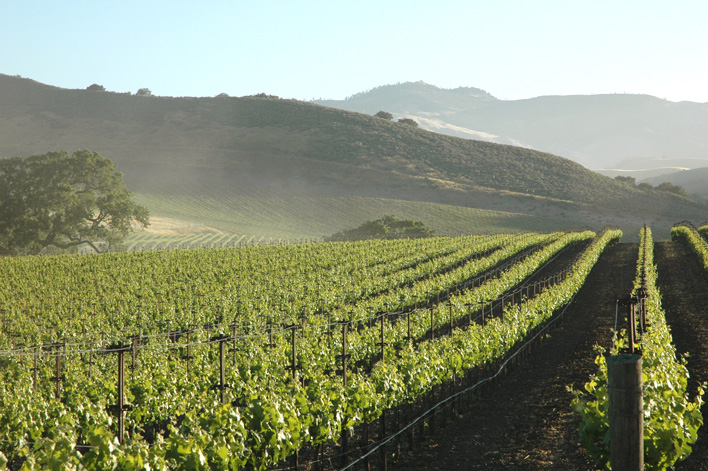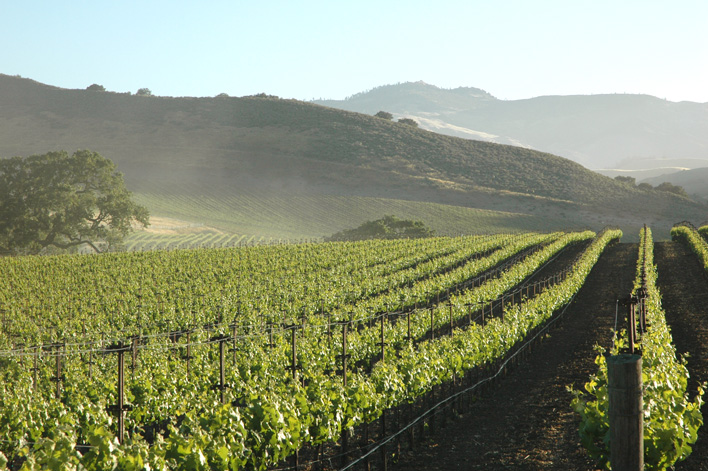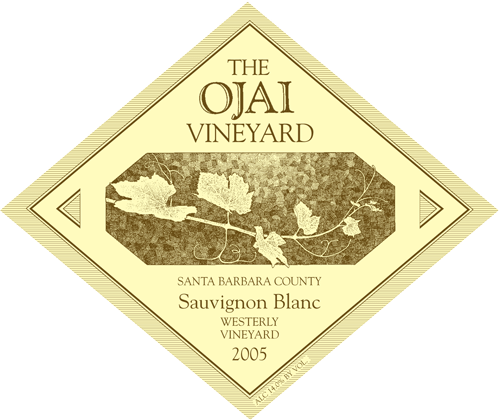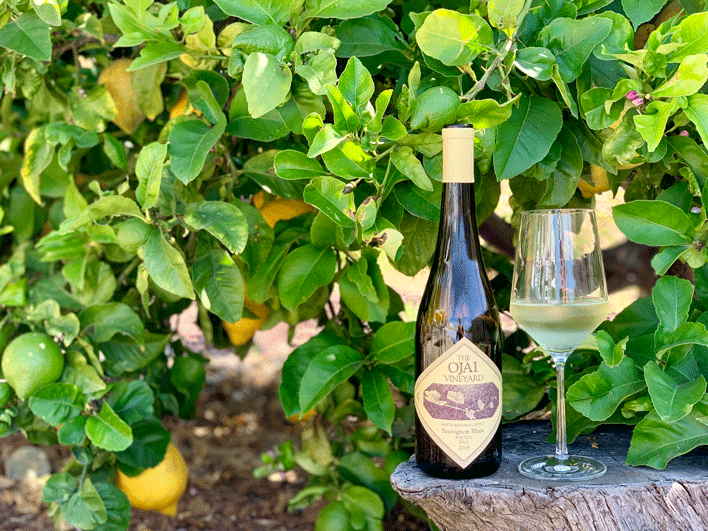
View Available vintages of Sauvignon Blanc
For those in the know, thinking of The Ojai Vineyard and Adam Tolmach brings to mind a legacy of crafting fine Syrah, Pinot Noir, and Chardonnay. But for about as much time Adam has been on a quest to perfect Sauvignon Blanc.

McGinley Sauvignon Blanc
Back in the mid-1970s when Adam was studying winemaking at UC Davis, he’d often make jaunts to Berkeley to find inspiration from bottles at Kermit Lynch Wine Merchant. Of the many varietals sampled back at his apartment in Davis, it was bottles of Syrah and Sauvignon Blanc that proved most captivating. He plumbed Kermit’s offerings of those varietals, and got to thinking about their possibilities in different pockets of California.
When Adam decided to move back to Southern California, Sauvignon Blanc was a good chunk of what he decided to plant at the Tolmach family ranch here in Oak View. The first crop came in 1983, and kicked off a lifelong
obsession with Sauvignon Blanc: how to make it, how to farm it, and where to farm it.
In The Ojai Vineyard’s early days, when Adam was working with the estate fruit and Buttonwood Farm in Santa Ynez Valley, he was making Sauvignon Blanc in more of a Bordeaux style: riper fruit, blended with Semillon, a supporting role for new French oak, all adding up to a more oily, easy-going drinkability.
“Those Bordeaux whites fascinated me at the time, but after awhile I realized I didn’t really like drinking them,” Adam said. “I found myself preferring the zestiness of Sancerre, and wanted to get back to making something that drinks like Sauvignon Blanc.”

If you ask me, Adam has done that exceedingly well over 20 harvests at McGinley Vineyard. This site is planted out in the Happy Canyon sub-AVA of Santa Ynez Valley, on long skinny fingers of rock extending into the valley floor.
Back in 1998 it was called Westerly Vineyard. Adam scouted the site in search of a long-term lease on Sauvignon Blanc acreage, and particularly liked a couple of small blocks where the vines appeared to struggle compared to their neighbors. Those blocks have only a foot and a half of topsoil it turned out, with a semi-fractured pan of serpentine rock underneath, so a vigorous vine like Sauvignon Blanc shows a more bridled growth habit. Less vegetative growth makes for a small crop that ripens efficiently without respirating out so much acidity—great for making concentrated, age-worthy and dramatic wine, albeit a wildly expensive crop. He signed the lease in ’98 and has held it since (but modified to organic farming in 2009).
If there’s any problem with our McGinley fruit it’s the wine’s age-worthiness, which from a more pragmatic perspective can mean a wine that just wants 10 years of courting before it disrobes itself. The unfortunate fact is that most consumers don’t think to age white wine, and the overwhelming majority of our Sauvignon Blanc bottles are opened within a year or two of release—when they are light and cool-hued, with stony minerality and gently etched botanical notes.
That’s all very nice, but it’s fair to say that for an aromatic white our young McGinleys demand some slowing down, focusing, poking about with the nose. Some potential to enthrall is shrugged off when drunk young.
If you look at a bottle that’s been aged at least 5 or, ideally, 10+ years after the vintage—say the 2005 or the 2009. There’s no poking about. The aromas blast out of the glass in a way that makes everybody pull their face away and smile. It’s like a toe-curlingly pleasant and tropical version of smelling salts: pineapple, citrus medley, flowers galore. And the power when it hits your tongue: when I was a kid my grandfather took me to air shows out at Edwards Air Force Base, and I remember when a B-1 bomber would do a low fly by. You’d see a noiseless dot and then before you knew it, you’d hear a sky-tearing whistle chased by a booming reverberance that went on the better part of a minute. That’s Adam’s aged McGinley—loud!

McGinley Sauvignon Blanc
That dilemma of potential vs. practiced drinking windows sparked some reassessment in Adam’s quest with McGinley’s Sauvignon Blanc: figuring out how to open up the wine for earlier rapture. We purchased some fruit from the higher yielding cane-pruned vines in other blocks (as opposed to the super low yielding cordon-pruned vines we farm), and we did trials blending in that smaller lot. Those results can be seen in our current release 2017 bottling. The younger vines did help open up the wine, but not with as dramatic effect as was thought possible.
Which takes us to the most exciting part of this quest: a new Sauvignon Blanc at The Ojai Vineyard! Last year (along with our McGinley fruit) Adam purchased some Sauvignon Blanc fruit from Portico Hills Vineyard, a newer planting right on the coastal outskirts of the town of Los Alamos. With vines planted just 3 feet apart on steep hillsides, tidy vertical shoot positioning, and a fierce corridor for coastal winds, there’s lots of potential to craft something showy.
The 2018 Portico Hills Sauvignon Blanc was bottled earlier this year at the end of March. Here at The Ojai Vineyard we like to assess and maybe release a wine after it has been bottle aged as long as it was barrel aged. We’re about halfway there now and the wine is still settling into the bottle.
Still, this newbie seems to promise radiance. Already that tropical whiff of pineapple core appears, and day two of being open there’s definitely that intersection of sweet fruit pith and flowers that our McGinleys show so loudly after aging. It’s also very tactile on the palate—there’s a touch more alcohol and a touch more acidity than the McGinley—and we found that this patch of Los Alamos Valley still features diurnal temperature swings that are notable enough to thicken the grape skins, providing that touch of tea tannin grit that our McGinley shows.
You could easily flesh out a Venn diagram comparing these two 2018 Sauvignon Blancs, but at this moment filling in the middle comes easier. We’ll be checking in on them later in the year, and will start sharing them and asking for your thoughts before too long—in keeping with bottle aging for at least the duration of barrel aging, expect to see Portico Hills offered this winter at the earliest.
A quick note for the McGinley fans—fear not, we have no plans to move on from this site. We’re pouring our twentieth bottling from the same rows right now, and the wine is dear to everybody here and many of you. Remember, making two vineyard designate Sauvignon Blancs is well couched within The Ojai Vineyard tradition of making our customers ask, “Which___did I buy?” We could go on this way or, alternatively, two sites could be fused and our Sauvignon Blanc could become a Santa Barbara County bottling. Or we could just stick with our mature vines at McGinley. The question will be resolved after more exploration.
By now most fans of The Ojai Vineyard know that Adam is not one to rest on laurels. Sauvignon Blanc is just one of many things we continue to explore and refine as the winery nears its fourth decade of craft production. Thanks for staying tuned and supporting the journey!








